TO
| Title | Date | Subject | Description | ||
|---|---|---|---|---|---|
| 126 |
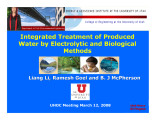 |
Integrated treatment of produced water by electrolytic and biological methods | 2008-03-12 | integrated treatment; produced water by electrolytic and biological methods; produced water | What we got from full scale analysis: 1-Composition of synthetic produced water. 2-Idea to develop an integrated scheme. 3-In other words, we just cannot just use any technique (oxidation or biological) to treat produced water. |
| 127 |
 |
Earth Energy Resources corporate presentation | 2008-02-22 | Oil sands; Earth Energy; Ophus Process; PR Spring, Utah; Bitumen; Oil sand mining; Tailings ponds; Extraction processes; Utah; Water consumption; Athabasca, Canada; Vernal, Utah; Simplot Phosphate Mine | Forward looking statements--Earth Energy Resources, Inc.: This presentation and the Company's website referenced in this presentation contain forward-looking statements including expectations of future production and components of cash flow and earnings. Investors are cautioned that assumptions used... |
| 128 |
 |
Availability of tar sands on public land: An overview | 2006-09-21 | Tar sands; public lands; Utah; Leasing on federal lands; Hydrocarbonaceous material; Oil shale; Tar sand development | Presentation summary: 1-Provide an overview of Utah Tar Sand Resources 2-Provide historical summary Tar Sand Leasing on Federal Lands; -Early leasing efforts-1960, -Combined Hydrocarbon Leasing-1981, -Energy Policy Act of 2005 3-Outline current leasing process |
| 129 |
 |
In-situ production of Utah oil sands bitumen | 2007-11 | in situ production; Utah oil sands; Utah reservoirs; in situ bitumen production; SAGD; case studies | In-situ production of oil-sand bitumen offers an excellent alternative to the ex situ processes that are based on strip-mining and surface extraction. In addition to leaving the landscape relatively undisturbed, in situ processes allow for partial upgrading of oil sands, leaving heavier, less profit... |
| 130 |
 |
Technical challenges to geological carbon sequestration | 2008-05-23 | carbon sequestration; reduce CO2 emissions; geological carbon sequestration; CO2; CCS economics; CCS. | Conclusions: 1-Current knowledge strongly supports carbon sequestration as a successful technology to dramatically reduce CO2emissions. 2-Current science and technology gaps appear resolvable at scale Deployment issues, including regulatory, legal, and operational concerns can be advised by science ... |
| 131 |
 |
Oil shale: An introduction | 2008-11-13 | oil shale; oil shale resources; mahogany shale; oil shale production | Presentation given in the Utah Oil Shale Resources and Technology Update, on November 13, 2008, in Salt Lake City, Utah. |
| 132 |
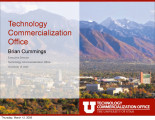 |
Technology Commercialization Office at the University of Utah | 2009-02-27 | Deep Coal Energy; Technology Development Office; QEMSCAN; Energence. | Overview of the activities and resources of the Technology Commercialization Office at the University of Utah and the relationship between the Technology Commercialization Office and emerging energy research and technologies in Utah, presented at the 2009 Western U.S. Oil Sands Conference by Jack Ha... |
| 133 |
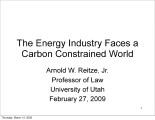 |
The energy industry faces a carbon-constrained world | 2009-02-27 | carbon regulation; energy industry; carbon control; CO2 sequestration; GHG. | Analysis of the impacts of potential frameworks for carbon regulation on the energy industry, presented at the 2009 Western U.S. Oil Sands Conference by Arnold W. Reitze, Jr., Professor, S.J. Quinney College of Law, University of Utah. |
| 134 |
 |
Government supported finance | 2008-11-13 | finance; government supported finance; DOE loan guarantee program | |
| 135 |
 |
Federal control of greenhouse gas emissions | 2010-04-28 | greenhouse gas emissions; federal control efforts; domestic legislation | Federal Control Efforts: 1) International 2) New Domestic Legislation 3) Using Existing Domestic Legislation |
| 136 |
 |
Resource potential of Utah oil sands | 2008-02-22 | Utah tar sand resources; tar sand resources; tar sand | Overview of Utah tar sand resources given by John Baza, Director of Utah Division of Oil, Gas & Mining. |
| 137 |
 |
The Utah Heavy Oil Center | 2006-09-21 | Utah Heavy Oil Center; oil shale; heavy oil production. | The mission of the Utah Heavy Oil Center is to provide interdisciplinary research support to federal and state constituents for addressing the wide ranging issues surrounding the potential of oil shale, oil sands and heavy oil production in the United States. |
| 138 |
 |
Environmental concerns for oil sands development in Utah--serious unanswered questions | 2008-02-22 | tar sands development; tar sand; Southern Utah Wilderness Association; BLM; PEIS; EIA; tar sand recovery | Overview of environmental issues and concerns associated with potential tar sands development in Utah presented by Stephen Bloch, Conservation Director of the Southern Utah Wilderness Association. |
| 139 |
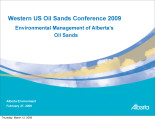 |
Environmental management of Alberta's oil sands | 2009-02-27 | environmental management; oil sands; Canadian oil sands development; crude bitumen; mineable resources; in situ resorces; oil sands deposits | Analysis of the challenges and successes of environmental management of Canadian oil sands development, presented at the 2009 Western U.S. Oil Sands Conference by Preston McEachern, Head of Science, Research & Innovation, Oil Sands Environmental Management Division, Alberta Environmental, Canada. |
| 140 |
 |
Utah oil sands: Social and economic factors | 2008-02-22 | oil sands development; economic and social impacts; bitumen. | Analysis of social and economic factors relevant to oil sands development in Utah. |
| 141 |
 |
Water treatment and reuse in oil sands development | 2008-03-12 | ozonization; heightened ozonation treatment; heightened oil sand extraction; water treatment; bitumen extraction fro oil sands; naphthenic contaminants removal; UHOP. | Discussion of heightened ozonation treatment and heightened oil sand extraction technologies. |
| 142 |
 |
OSEC's White River project | 2008-11-13 | OSEC; White River project; Utah oil shale resources and technology | A presentation given at the Utah Oil Shale Resources and Technology Update on November 13, 2008, Salt Lake City, Utah. |
| 143 |
 |
P.R. Spring and Hill Creek Tar Sand Areas: A resource assessment (in progress) | 2008-02-22 | P. R. Spring; Hill Creek Tar Sand Areas; Uinta Basin; Green River; resource assessment | The P.R. Spring-Hill Creek Tar Sand Area is located at the southern flank of the Uinta Basin. The area is generally bounded by T. 12 S. in Uintah County, extending southward to T. 17 S. and the Roan Cliffs in Grand County. It is further bounded by the Green River on the west and the Utah-Colorado st... |
| 144 |
 |
Temple Mountain Energy's asphalt ridge oil sands project | 2006-09-21 | Temple Mountain Energy; oil sand; oil sands project; Asphalt Ridge. | An overview of Temple Mountain Energy's asphalt ridge oil sands project. |
| 145 |
 |
Production of oil shale from the Green River Formation in Utah | 2007-11 | oil shale; oil shale production; Green River formation. | The largest deposits of oil shale in the world are documented to be in the Green River Formation of western United States. If this oil resource (conservative estimate of 800 billion barrels recoverable) could be used to meet a quarter of the present U.S. demand for petroleum products, the resource w... |
| 146 |
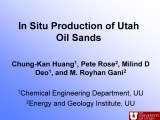 |
In situ production of Utah oil sands | 2008-03-12 | in situ; Utah oil sands; oil sands production; tar sand deposits; Whiterocks eolian sandstone | |
| 147 |
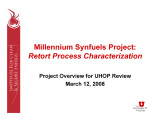 |
Millennium synfuels project: Retort process characterization | 2008-03-12 | synefuels; retort process; retort process characterization; energy security; retorting technology; oil shale processing; hybrid energy system; HES | -Energy security issue has led to interest in coal-to-liquids technologies, -One approach use retorting technology commonly associated with oil shale processing, -Hybrid Energy System (HES) technology developed by: Millennium Synfuels, LLC - joint venture of Ambre Energy Pty, Ltd (Australia) and Oil... |
| 148 |
 |
Status of the OSEC White River oil shale project | 2010-04-28 | OSEC; shale; status report. | Major milestones in 2008: 1) Formed joint venture with Petrobras and Mitsui 2) Acquired Cliffs Synfuel Corporation 3) Initiated feasibility study |
| 149 |
 |
Enhanced in-situ production through fracturing | 2010-04-28 | in-situ production; fracturing; fracturing methods | Rationale For Fracturing: 1) Ultra-Low Matrix Permeability 2) Poorly Interconnected Fracture Network 3) Desire to Maximize Surface Area, Minimize Transport Distance In Matrix and Increase Conductivity of Flow Paths For Production 4) Increase Surface Area, Increase Fracture Frequency |
| 150 |
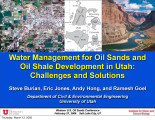 |
Water management for oil sand and oil shale development in Utah: Challenges and solutions | 2009-02-27 | water management; oil sands; oil shale; integrated water management | Analysis of the water management and impact issues relevant to oil sands and oil shale development in Utah, presented at the 2009 Western U.S. Oil Sands Conference by Steve Burian, Assistant Professor, Department of Civil and Environmental Engineering, University of Utah |
